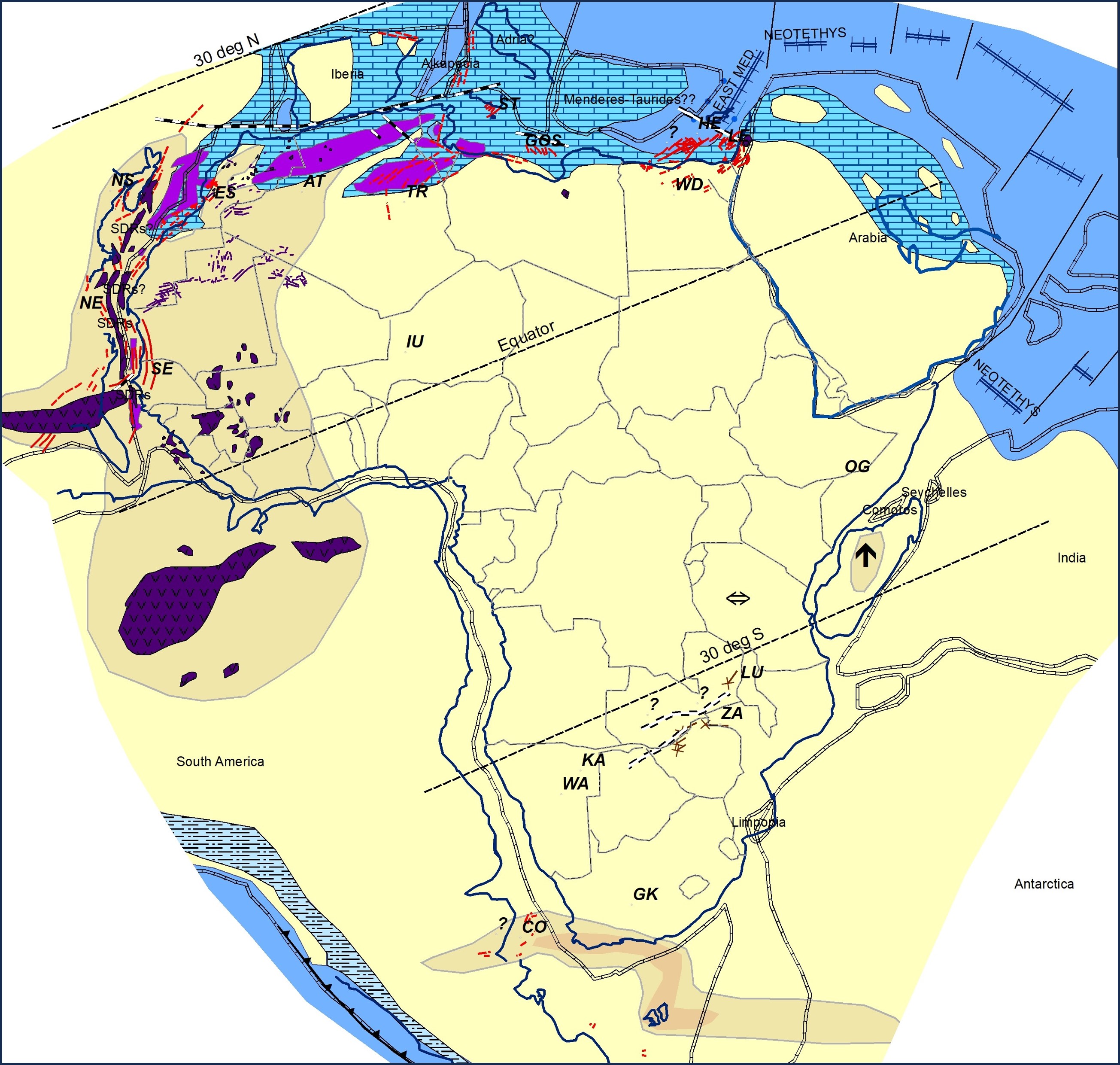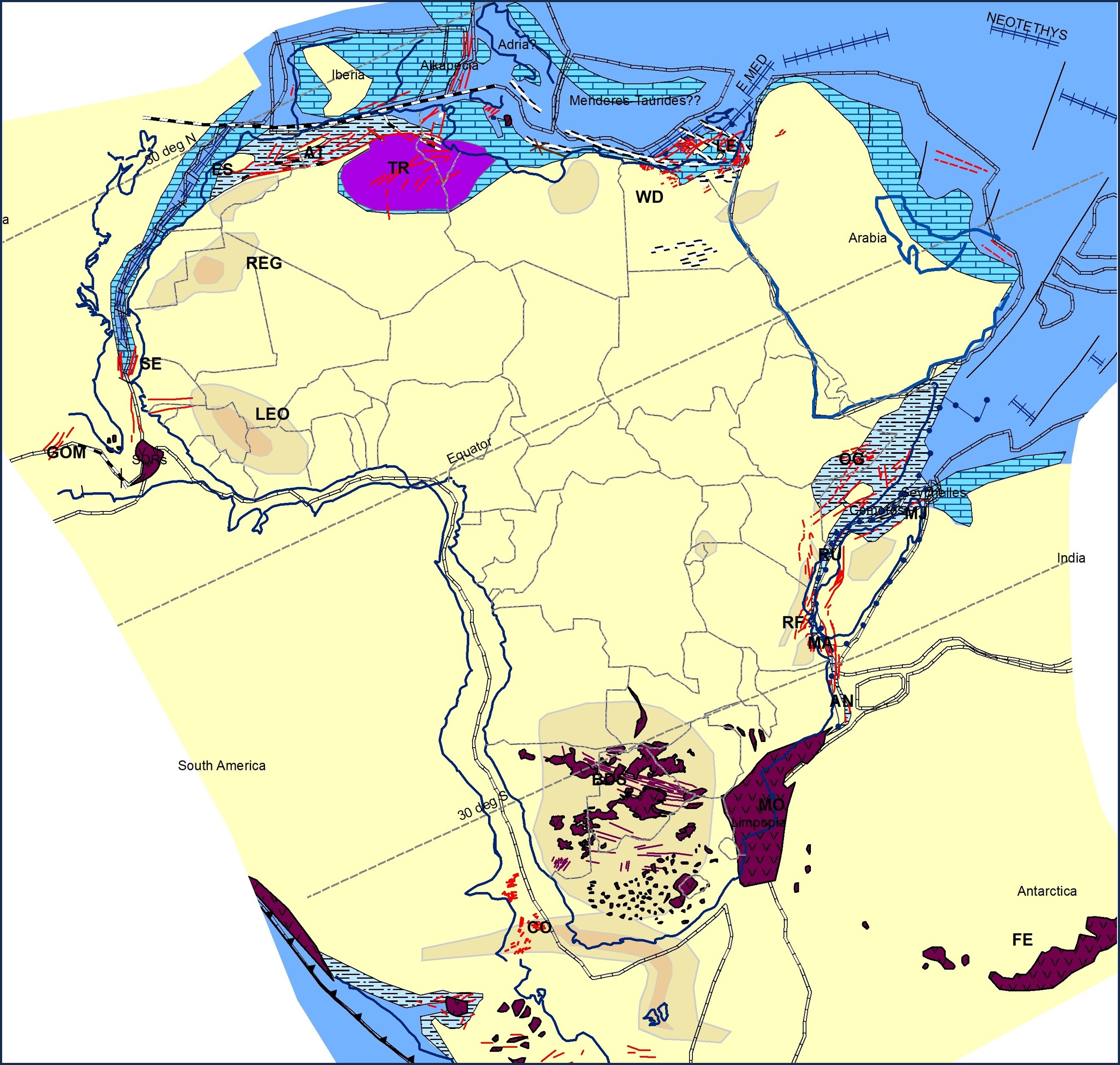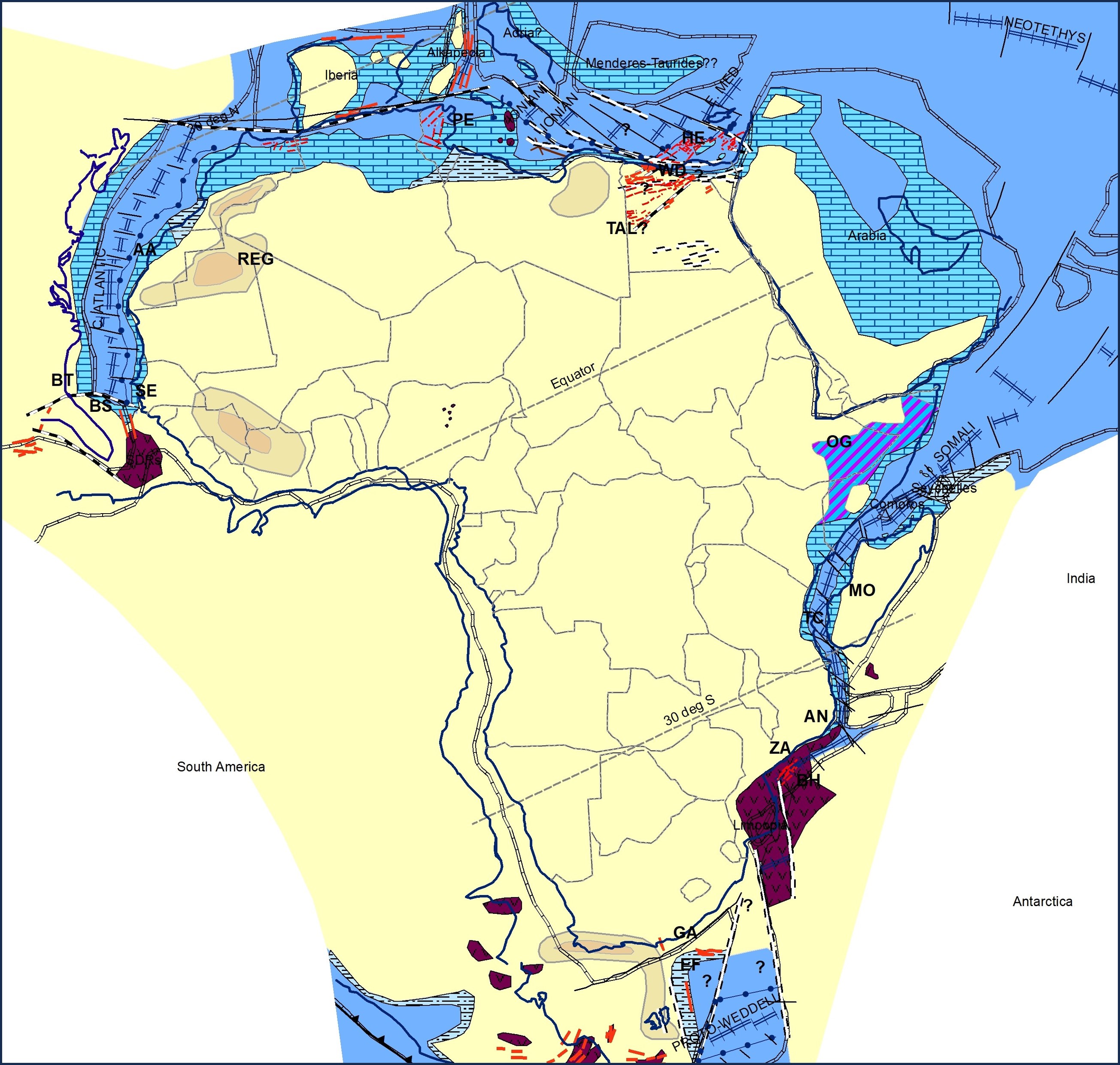Jurassic Tectonic Maps of Africa
For methodology behind these maps, click here. For legend for these maps, click here . For paleogeography, facies distribution, paleotopography, paleodrainage and paleoclimate at this level click here
To comment and contribute to these maps use form below
Click each map to expand
Click references to get full details and/or access
Rhaetian/Hettangian Boundary 200+-5Ma
Major alkaline flood basalts of latest Triassic age are erupted in Israel Unconformity Norian to Hettangian age (Gardosh et al, 2011). Rifting seems to be propagating westwards in Egypt from Israel through Sinai
The Azores-Gibraltar Transform (AGT) is initiated as rifting is established in both the future Central Atlantic and Ligurian (Alpine) oceans.The intensity of rifting has decreased in the Newark (NE), Nova Scotia (NS), Atlassic (AT) and Sicilian rifts (SI), though a second milder pulse is proposed in Morocco (Frizon et al, 2008, Escoca et al, 2021). A major magmatic event occurs at the Triassic-Jurassic boundary, which is defined at the mass extinction associated with the Central Atlantic Magmatic Plume (CAMP). The distribution of these volcanics is largely after McHone (2000). Within tectonically controlled inlets such as the Triassic Basin (TR) and incipient Central Atlantic, evaporites are well developed. On the American side, there is magnetic evidence for the emplacement of seaward dipping reflectors around this time: the only reports of these on the African side come from presentations by Petrosen over Senegal.
The ‘Karoo’ rifts are now inactive (Macgregor (2018)). Over the Zambian and Tanzanian rifts, an unconformity is seen between Triassic and Late Cretaceous, capping inversion structures that increase in intensity to the SW. The lack of any displacement on Pleinsbachian dyke swarms suggest this inversion could be placed in this time period. This inversion could indicate a reversal of the STASS wrench faults.
Pleinsbachian 185+-7Ma
Oceanic crust formation in the Eastern Mediterranean is likely initiated in Early to early Middle Jurassic (post-rifting/flood basalts and prior to Ligurian ocean spreading) : the eastern area may open first. Horsts and grabens in the Levantine Basin (LE) trend NNE-SSW , implying transform movement along the sharp Egyptian margin (Longacre et al, 2007: Tari et al, 2012). At some point, extension is transferred to the Herodotus (HE) Basin, which hyperextended, leaving the Eratosthenes High as a stranded block (Gao et al, 2020). A large ?breakup unconformity is seen in Cyrenaica (CY, A1-28) separating Hettangian shallow marine and Callovian deep gravity deposits in the A1-28 well (D. Boote, proprietary work for Lynx). This can be connected with evidence of transform tectonics in the Gulf of Sirt (GOS, Jagger et al, 2018). and as far as the incipient Azores-Gibraltar transform. Tugend at al (2019) also concludes on the basis of palaeomagnetic and other geological data (e.g. Maltese flood basalts) that Ionian Sea spreading likely occurred at this time. Deep marine environments are established by the Aalenian in Sicily (Catalano et al, 2013). However the Menderes-Taurides blocks cannot be moved too far west while holding Apulia in place (as evidenced by paleomagnetics) and the phase of NNE-SSW spreading may thus have been short lived.
The model adopted for the opening of the Central Atlantic is that of Labails et al (2010), with first oceanic crust around 190Ma emplaced north of the Blake Spur only. SDR formation commences south of the Blake Spur. These are now located off Surinam and Guinea (Trude, 2023)
A new phase of rifting commences over East Africa, preceding opening of the Somali Oceanic Basin, perhaps as early as Toarcian (Reeves, 2018). Macgregor (2018) interprets early syn-rift condition in the Pleinsbachian over rifts such as the Mandawa (MA) Basin of Tanzania, preceding the main syn-rift conditions in the Toarcian. Early Jurassic rifts are also interpreted on seismic offshore Somalia (Davidson et al (2018)), which will go into hyperextension. Marine conditions transgressed in the Pleinsbachian as far south as southern Somalia, prior to of a northern derived marine transgression and salt deposition in the Toarcian Macgregor (2018), which likely reached Mozambique. Toarcian salt is known from the Mandawa (MA) Basin of Tanzania and the Majunga Basin (MJ) of Madagascar, while salt diapirs are interpreted on seismic in the offshore Angoche (AN) Basin of Mozambique (INP, 2023) . A major ‘Karoo’ volcanic episode affects southern Africa (Pevye 2015) , Antarctica and Tasmania in the earliest Toarcian (circa 179Ma) and is tied to a significant extinction event. The lack of any subsequent displacement on Botswanan and Namibian dykes of this age indicates that there have no transform displacements crossing this area at any time since. At 177Ma, volcanism began on the Mozambique margin (Mueller 2019) with the emplacement of seaward dipping reflectors.
Bajocian 170+-5Ma
The Eastern Mediterranean/Ionian seas may nearing the end of a relatively short drift phase, as extension is being transferred in the Ligurian Sea (Handy et al, 2010), inhibiting further Ionian spreading. The portrayal of the Eastern Med. at this time is after Tugend at al (2019). The presence of Middle Jurassic flood basalts on the western margins of the Ionian Sea (Reeh and Aifa, 2008) may suggest continued . These are younger than the Asher Volcanics of Israel, suggesting a E to W propagation of spreading activity. Many authors believe that the Western Desert (WD) rifts of Egypt were initiated at this time (e.g. Moustafa, 2020) , though Bosworth (2022) does not think they rifted till the Late Jurassic. These rifts are reported to be in a transtensional phase, (e.g the Alamein Basin) which is speculated to tie to the period of spreading of the Eastern Mediterranean (Bosworth (2022). . A SE Asia style model involving initial transtension (and later reversal and transpression), perhaps also including movements on the Trans-African Lineament (TAL), can be proposed.
The rate of drift is accelerating in the Central Atlantic, but with oceanic crust only reaching the Blake Spur (BS) (Teasdale in Casson, 2020) . Sheridan (1981) interprets breakup on the Blake Plateau as basal Callovian while Trude (2023) still has areas south of here (Guinea/Suriname) still in an SDR phase.Indian Ocean unzipping and spreading is far more rapid. The
Somali Basin is now opening, with oblique spreading extending to Tanzania and
perhaps northern Mozambique (Reeves, 2018).
The Davie Transform is yet to form (Phethean,
2016). A major transgression is
observed in many of these basins around Bajocian times, which may mark break up
(Macgregor
(2018)). A volcanic margin is forming over the Mozambique margin. Figuerido et al (PESGB presentation, 2021)
interprets first oceanic crust at 170Ma in the Angoche (AN) Basin and offshore Zambezi (ZA) , though this
was abandoned in favour of more outboard spreading centre 10My later, leaving
the Beira High (BH) as a stranded block. Roche et al
(2023) transfers the extension in this region to the south on a large
transform , where the proto-Weddell Sea could be opening. Rifting of the Agulhas Basins in South Africa
may be commencing in the deepest half
graben of the Gamtoos (GA) Basin (Mcmillan
et al, 1997). This is likely to be an extension of the East Falklands (EF)
Basin, where a very thick Jurassic section seems to open up over major bounding
faults in a possible pull-apart setting.
Kimmeridgian 155+-5Ma
Most Tethyan
oceans from the Proto-Caribbean to the Middle East are now rapidly spreading,
as are various segments of the Indian Ocean. The
North Africa transform margin is now clearly developed, with major
displacements now on
Azores-Gibraltar Transform (AGT) (Handy
et al, 2010) as the Central
Atlantic and Ligurian oceans open. In response to these
greater displacements to the west, transtensional rifting in the Western Desert
(WD) continues to propagate in that direction.
The Jebel El Akhbar and Marmarica Basins thus open as pull-aparts bounded by the North Cyrenaica dextral shear zone (Martin et al, 2008, Geology of Eastern Libya)
. Isolated rifting also occurs in
Tunisia and Morocco.
A switch to N-S spreading in the
Somali Basin initiates the Davie Transform (DT), which is entirely developed
within oceanic crust (e.g. Pheathan, 2016). A correlation of organic shales at this level between DSDPs on the
Maurice Ewing Bank (MEB) to those in the Algoa (AL) and Gamtoos (GA)
Basins fixes the relative positions of the African and South American
plates at this time, supporting the reconstruction of Lovecchio et al,
2020. There is no marine strata seen in any of the basins north and west of
the Falklands so the marine link in the Agulhas Basins has to come from areas
east of the islands. The first marine strata are encountered in the Gamtoos
Basin in the Kimmeridgian while marine strata are not seen in the Bredasdorp
(BR) Basin to the west till the Tithonian (Mcmillan
et al, 1997). A suggested early movement on the Agulhas transform later in
the Jurassic probably therefore brought East Falklands Basin waters into
contact with the Bredasdorp Basin. A series of rifts are also thought to become
active in southern Mozambique at this time (Salman and Abdula,
1995) and could have a common origin. The geodynamic model for the East
Falklands Basin remains uncertain. An oceanic crust base is suggested by Eagles and Eisermann
(2020), though a reported significant crustal thickness seems incompatible with
such a model. The alternative model is that of a pull apart basin.
NW-SE trending rifts become active in Yemen at this time but exploration for these in Somalia has failed to find thick Jurassic sections (Purcell, 2018). The Central Atlantic now extends to Guyana (Trude, 2023) .



